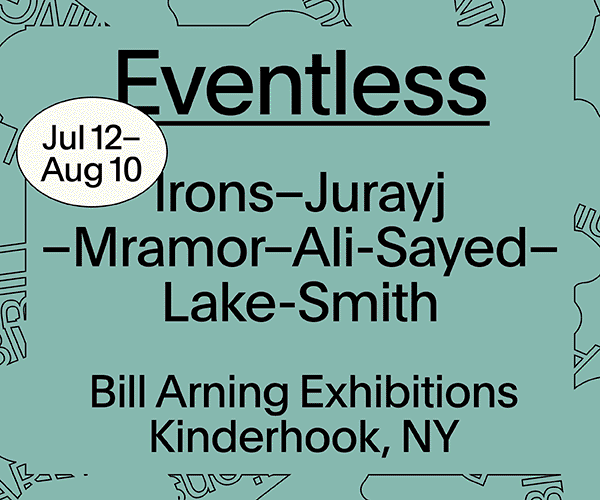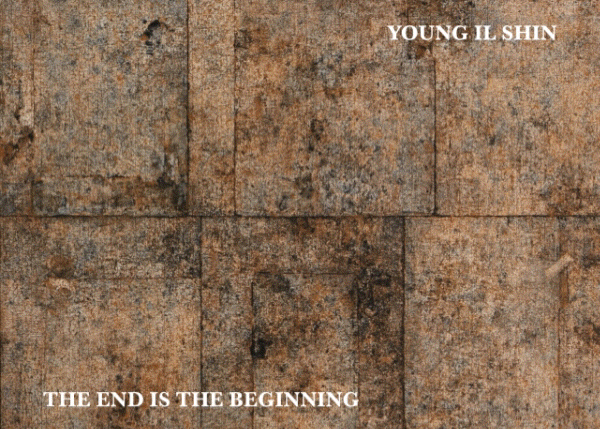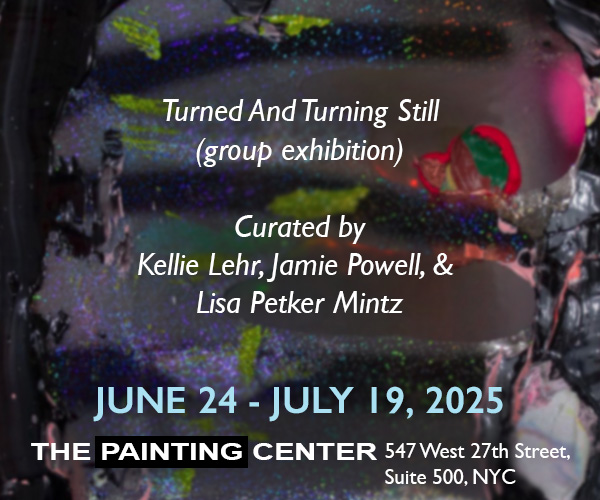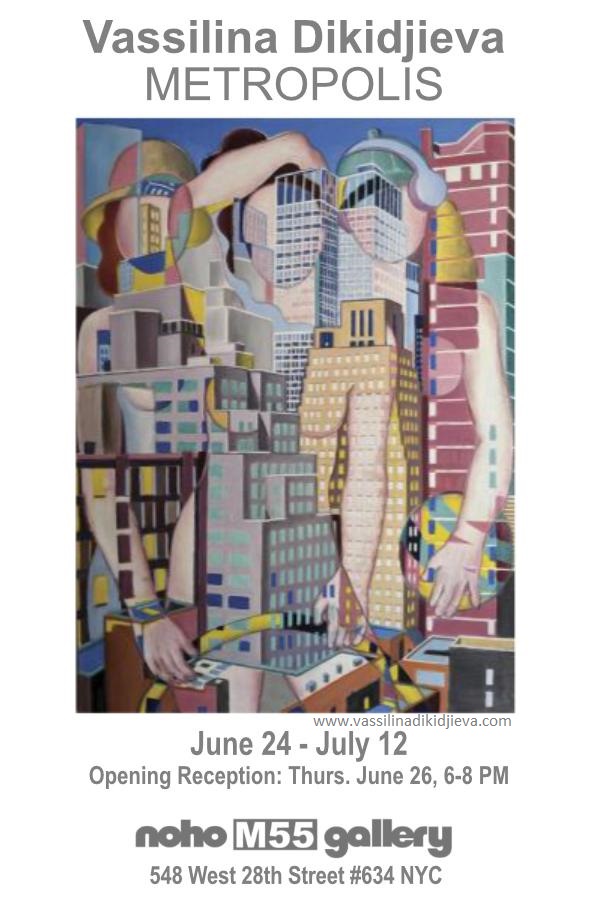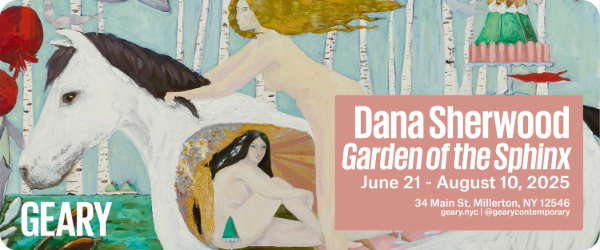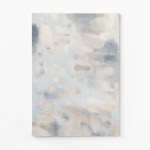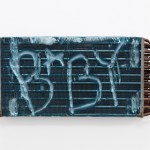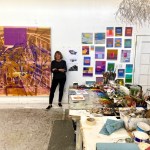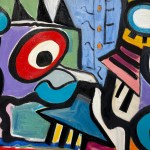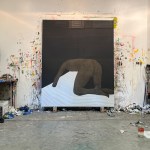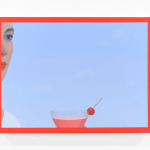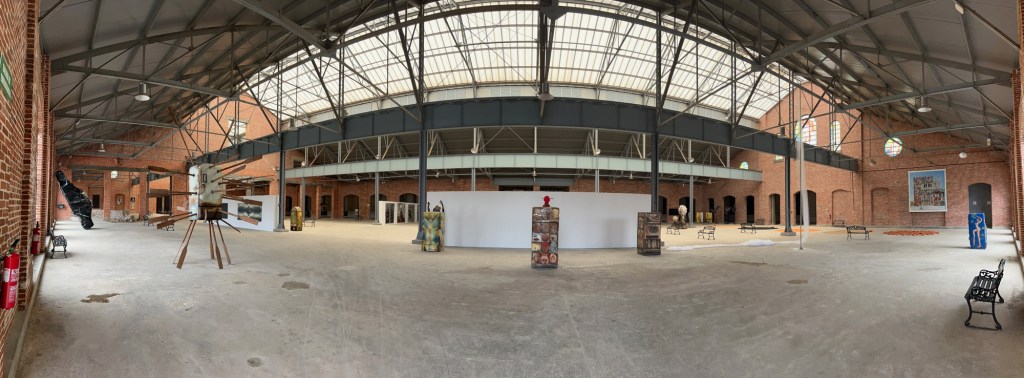
Contributed by Katarina Wong / The recent 15th Havana Biennial, organized around the aspirational theme of “Shared Horizons,” unfolded across the city in November 2024 and ran through February 2025. It involved about 400 artists, curators, and art historians among 80 listed venues throughout Havana, several discussed here. Like its predecessors, the exhibition showcased art from Latin America, the Caribbean, Africa, Asia, and the Middle East – art of the global majority often not seen in American or European galleries or museums.
Centro de Arte Contemporanéo Wifredo Lam
Nelson Ramírez de Arellano, the director of The Wifredo Lam Center for Contemporary Art, is the lead organizer of the Havana Biennial. At his home institution, “Shared Horizons” highlighted installations by solo artists as well as artist collaborations.
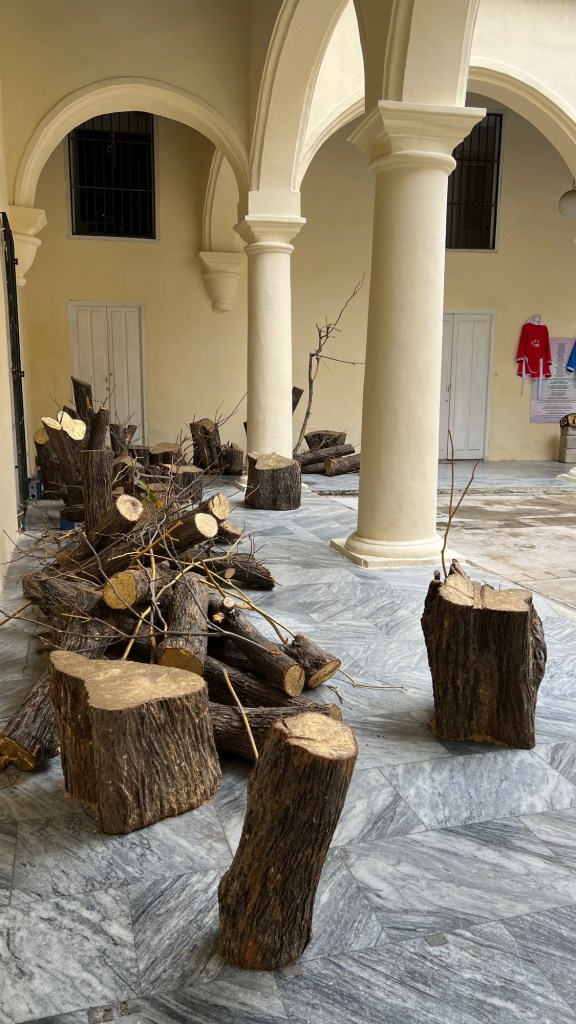
Ira Kononeko is a Russian-Ukrainian artist born and raised in Cuba. She and her fellow Cuban collaborators Bryan J. Romero and Henry Williams have created an installation of chopped tree trunks and pruned branches in the Center’s ground-floor atrium. The cut edges of the stumps are painted gold, memorializing the now dead trees, and the pieces are assembled into a new notional grove. Poetically entitled “Toda la sombra que me puedas dar, la quiero. Viva o muerta” (“All that the shade is able to give me, I love. Alive or dead”), the installation subverts the idea of refuse, insisting that things don’t need to be discarded to continue to have use or significance, even as they pass from their recognizable forms.

Iranian artist Reza Ramesh and Cuban artist José Nazabal invited members of the LGBTQ+ community to join them in creating Acción 502, an installation composed of black line paintings on billowing white fabric banners. Each depicts a version of Saint Sebastian, often referred to as a gay icon. Some of the banners show him alone and on others he is supported by another male figure. All of them, however, are headless. Walking through the installation is to pass through images of pain, sacrifice, and also beauty until reaching the image on the unlit back wall.
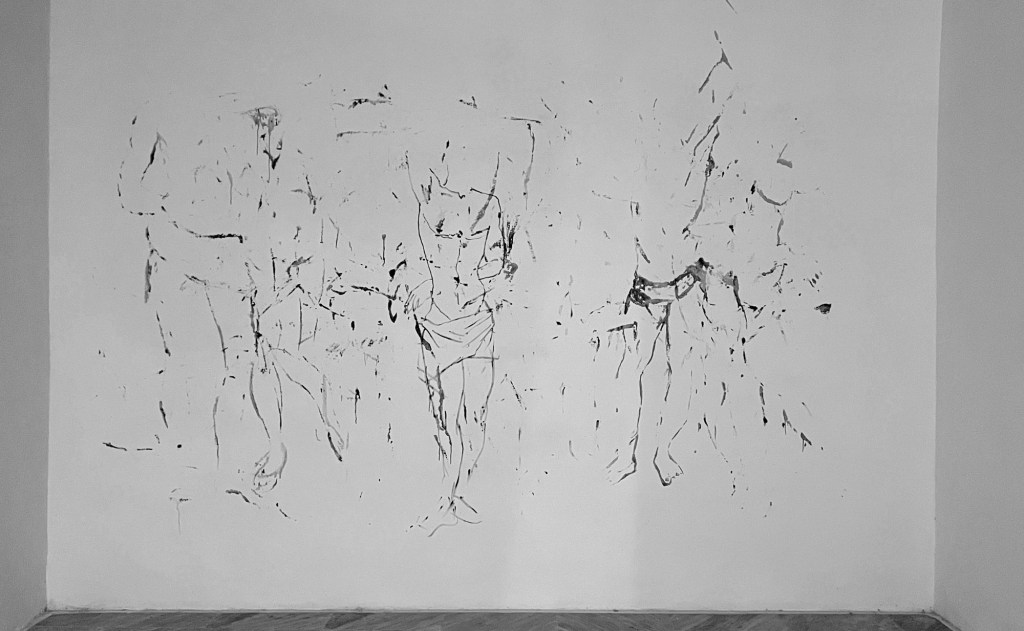
This final painting, apparently created by pressing the freshly painted banners directly on the wall, is an accumulation of all the collaborative actions that went into making the installation – metaphorically, a ghostly image of the saint’s body.
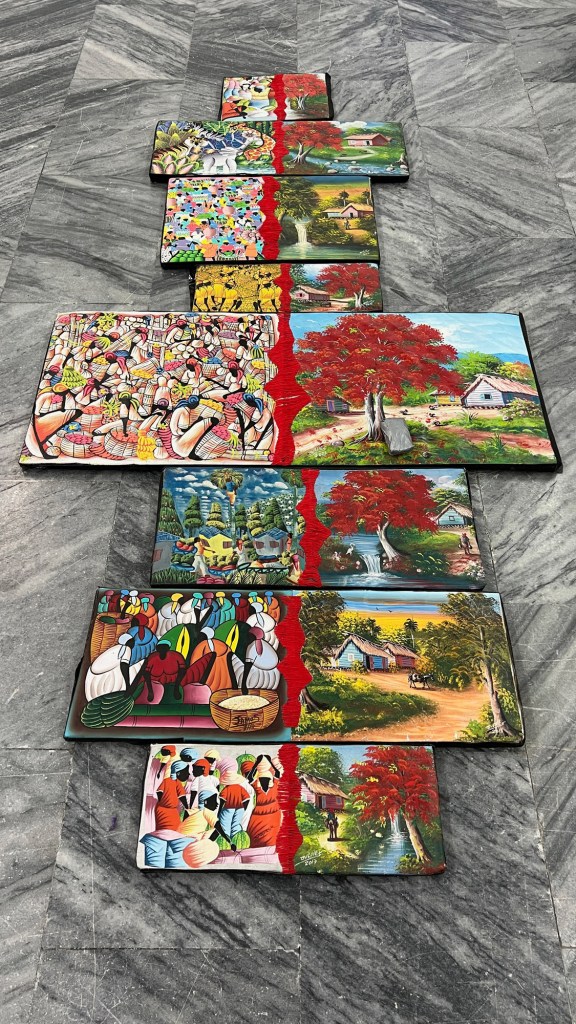
Dominican artist Jorge Pineda, who died in 2023, created Queloides by literally stitching together paintings typically sold in Haiti (left side) and the Dominican Republic (right side) – a clear reference to how the two countries share a single island. Pineda configures these tandems into a child’s game of hopscotch, which at first blush conjures light-hearted nostalgia. The title, however, translates as “keloids” – scars that form following trauma – registering a much darker message about the results of slavery and heedless geopolitics.
Museo Nacional de Bellas Artes (Artes Universal)
The National Museum of Fine Arts is housed in two buildings, one dedicated to “artes universal” – art from around the world – and the other to Cuban art. Curators Jorge Fernández Torres and José Manuel Noceda decided to focus their show “La tradición se rompe pero cuesta” (“Tradition is broken but at a cost”) on women artists of the Caribbean, a refreshing contrast to many of the other exhibitions.
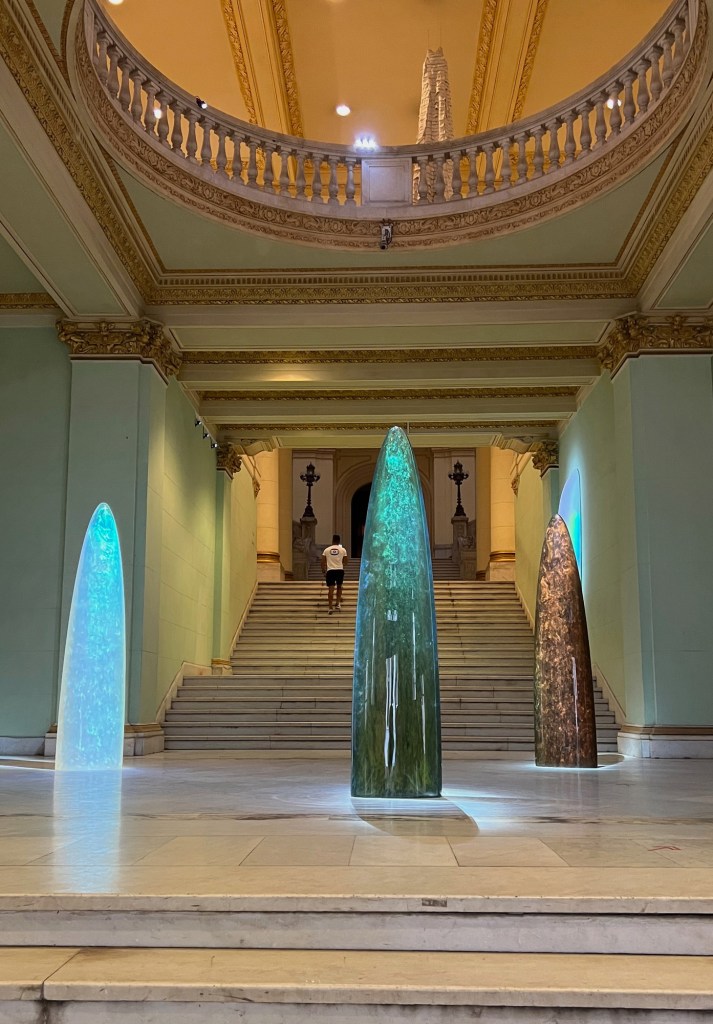
Puerto Rican artist Gisela Colón‘s Matería prima del Caribe (raw material from the Caribbean) consists of three glowing large monoliths and greets visitors entering the museum. Colón’s materials list includes “aurora particles, star dust, cosmic radiation, intergalactic material, ionic waves, gravity, energy, and time,” a strong hint that no matter how visually captivating these sculptures are, they should not be mistaken as merely decorative. She writes that as a child she played with the bullets from her father’s pistol, and that these monoliths transform bullets – agents of destruction – into something more cosmic and lifegiving, harnessing the power of nature in the service of resiliency and survival.
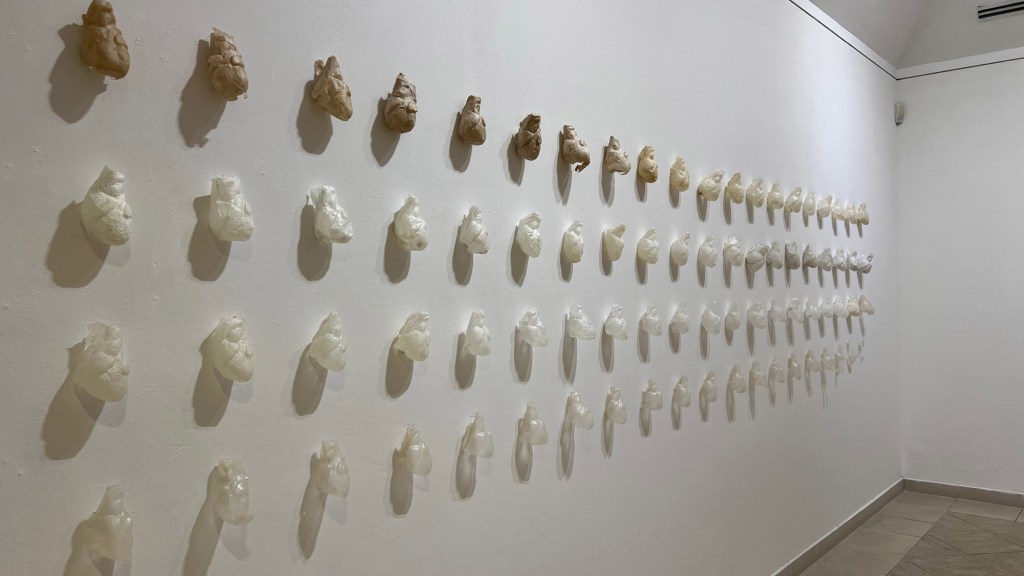
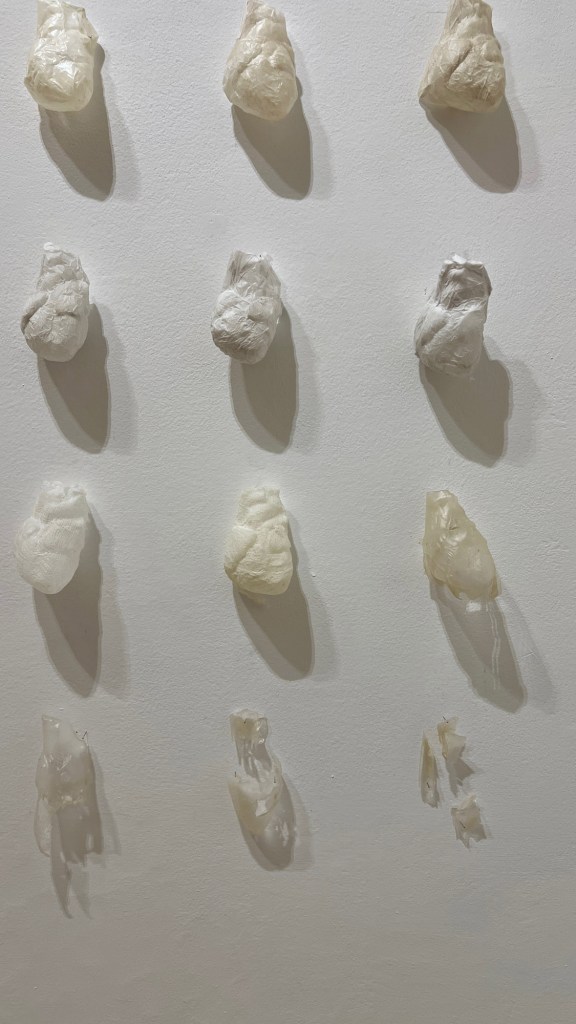
Drawing on her father’s heart attack forty years ago, Jaime Lee Loy, an artist from Trinidad & Tobago, displays 79 hearts, which represent the age her father would be today. Together, these forms tell her origin story as an artist: the hearts are in a process of disintegration, mirroring both her father’s fragile heart and her own health challenges due to childhood trauma. The delicate, transparent forms are both present and barely there, hovering in the precarious space the living inhabit.
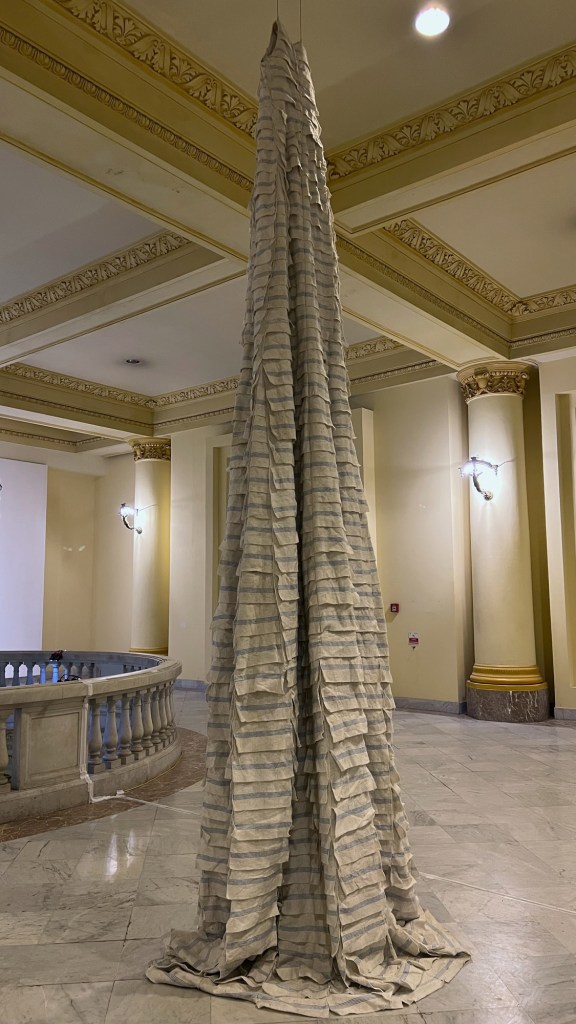
Immaculada cascades nearly 20 feet down from the museum’s ornate ceiling. From middle distance, it seems to be a kind of over-the-top dress, disproportionately long, that belongs in this Beaux-Arts building. Up close, however, it becomes clear that the gentle ruffles flowing onto the floor are made not of expensive silks or satin but rather hundreds of cleaning cloths of the type used in households across the Dominican Republic, the artist’s homeland. Thus, she cheekily plays on the term “immaculate” by suggesting both divine construction and women’s humble labor.
Museo Nacional de Bellas Artes (Arte Cubano)
The Cuban art building of the National Fine Arts Museum featured two exhibitions on abstraction in Cuba in the 1950s, one of which, The Vagaries of History, was devoted to several Cuban women artists. Some like Zilia Sánchez and Carmen Herrera have recently gained international renown. Others are lesser known, yet important in their own right, as this exhibition demonstrates.
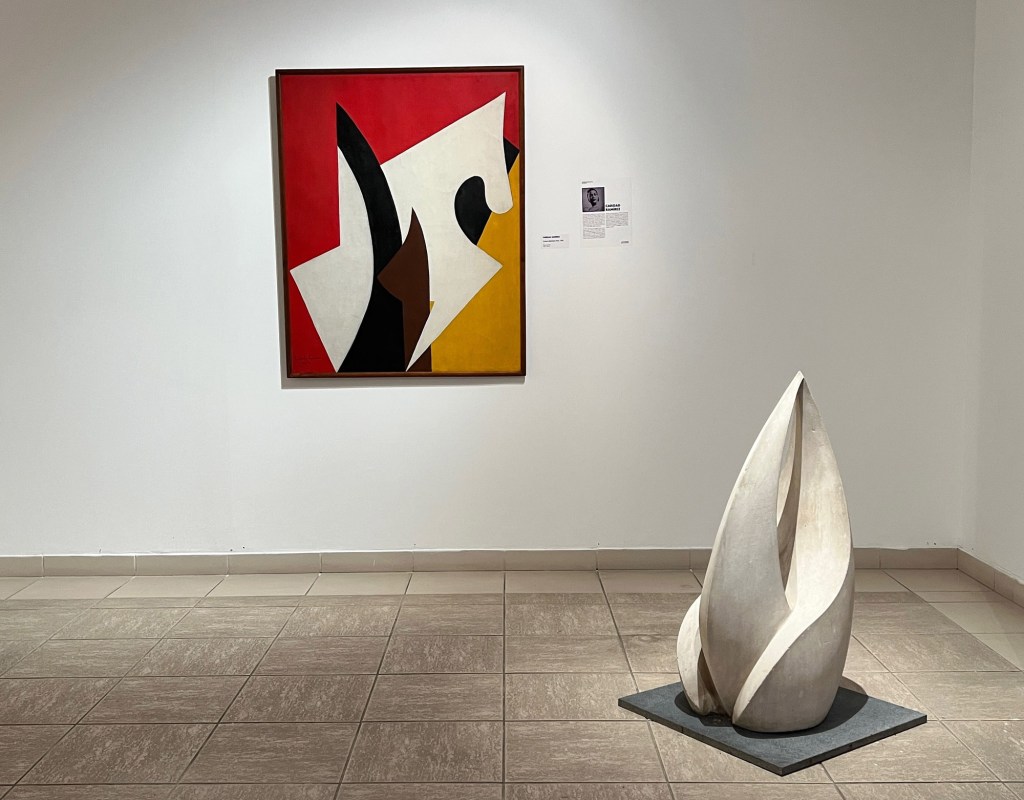
Caridad Ramírez began showing her work in Havana in the 1930s, when she was barely 20 years old. She eventually moved to Paris, where she was exposed to abstract art, subsequently returning to Cuba with a new creative vernacular. Though she continued to work abstractly, her paintings were strongly influenced by the natural world she grew up with, as seen in her painting Campos abstractos (abstract fields) and Flor (flower).
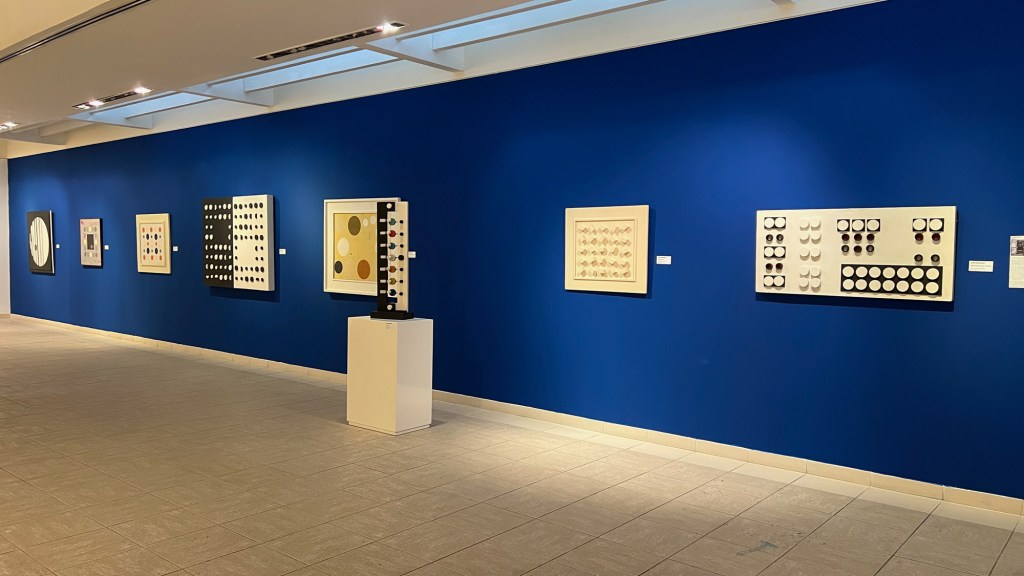
Loló Soldevilla was a contemporary of Ramírez and also spent time in France. Unlike Ramírez, however, she didn’t seek inspiration from the natural world. Instead, she was a strong proponent of concrete abstraction, making art that focused on more formal elements. Notably, she incorporated sculptural elements into her panels, experimenting with non-traditional materials in search of new forms of equilibrium. Her work calls to mind contrapuntal music: each element is deliberately placed in relation both to another and to the whole, creating a tight geometry. In 1957, she co-founded the Color-Light Gallery in Havana with her husband. Though it was open only for four years, the gallery helped establish the concrete art movement in Cuba.

Unlike Ramírez and Soldevilla, Gina Pellón moved to Paris and never returned to the island. Despite that separation, she said the color and heat in her work was “without a doubt from my Cuban origins.” Pellón’s work eventually became more figurative, but Fragmentos from the late 1950s, reveals her grappling with abstraction differently than some of her colleagues in this exhibition. With its broad, gestural paint strokes, the painting seems to be influenced by Jackson Pollock and other Abstract Expressionists. By contrast, Herrera’s work features clean edges, Soldevilla’s stark minimalist colors, and Ramiréz’s direct references to nature.
Plaza Vieja
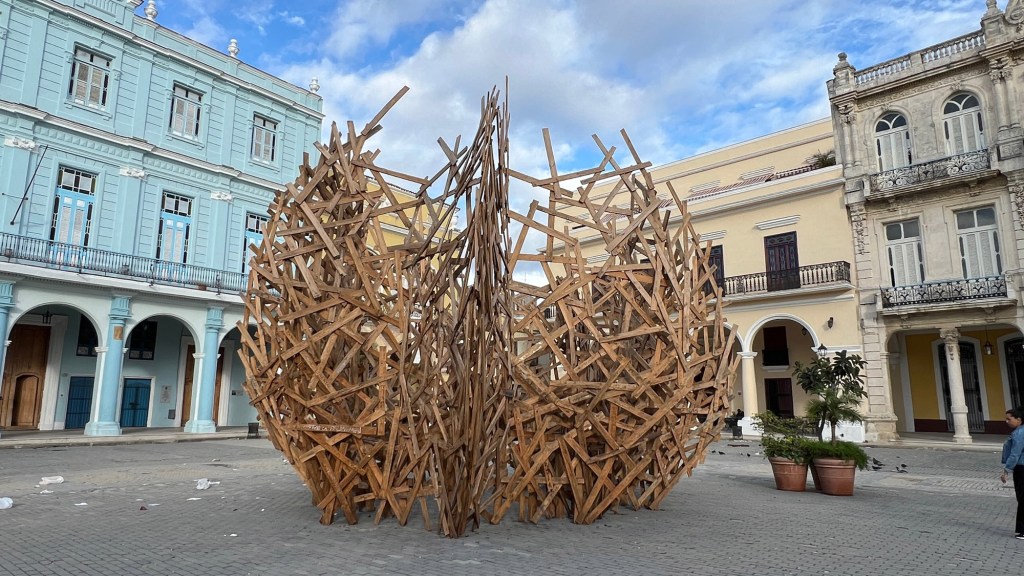
One of the pleasures of Cuba in the winter is being able to stroll its streets without melting from the heat and humidity. During the biennial, this pleasure is compounded by the unexpected discovery of installations in very public areas, like the Plaza Vieja. This “Old Plaza” is an open space encircled by brightly painted colonial-style buildings. This year, German sculptor Martin Steinert was invited to create an installation there. Nube de Madera: La Arquitectura de los Deseos (cloud of wood: the architecture of desires) is a towering open construction of planks onto which visitors are invited to inscribe their wishes. The construction of the structure mimics the way many Cubans desperately cobble together found materials in an attempt to preserve their homes, and the messages reflect individual aspirations, current events, and the challenging circumstances Cubans live in. Some were prosaic (“I want to be a millionaire”), others sweetly hopeful (“you and me in Paris”). Declarations of support for Palestinians, for example, were more sobering.
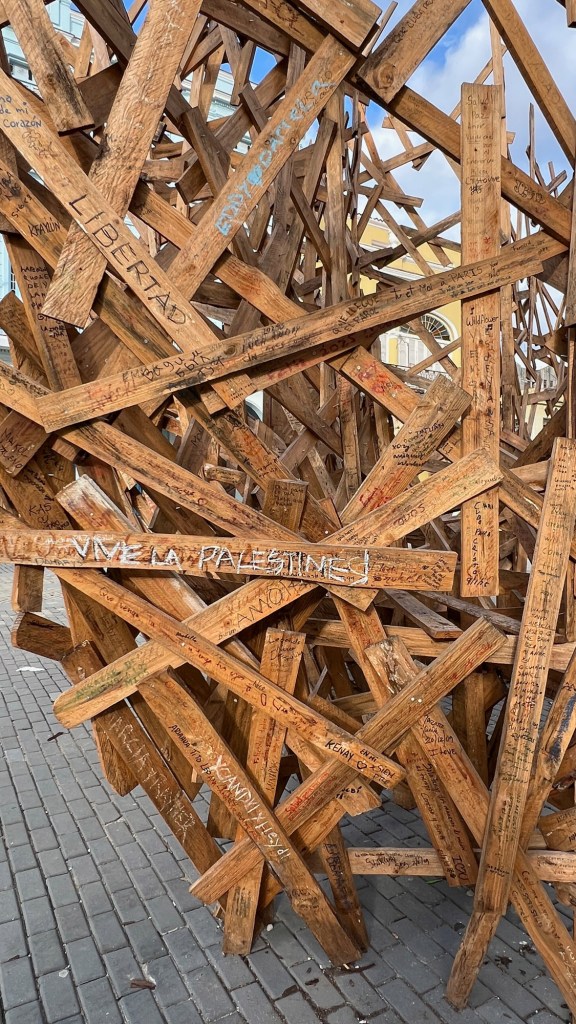
Estación Cultural Línea Y 18
For visitors to Cuba, the Havana Biennial presents the opportunity to discover new art and artists, as well as new venues. At the Biennial ten years ago, El Castillo del Moro, the sixteenth-century fort that sits across the bay from Old Havana, showcased solo artists and small exhibitions in its stone rooms. In 2019, a former Chinatown theatre-turned-gallery hosted one of the most compelling shows of that biennial. This year, the cavernous Estación Cultural Línea Y 18, a former streetcar factory in the residential neighborhood of Vedado, presented a strong exhibition of artists culled from past biennials.
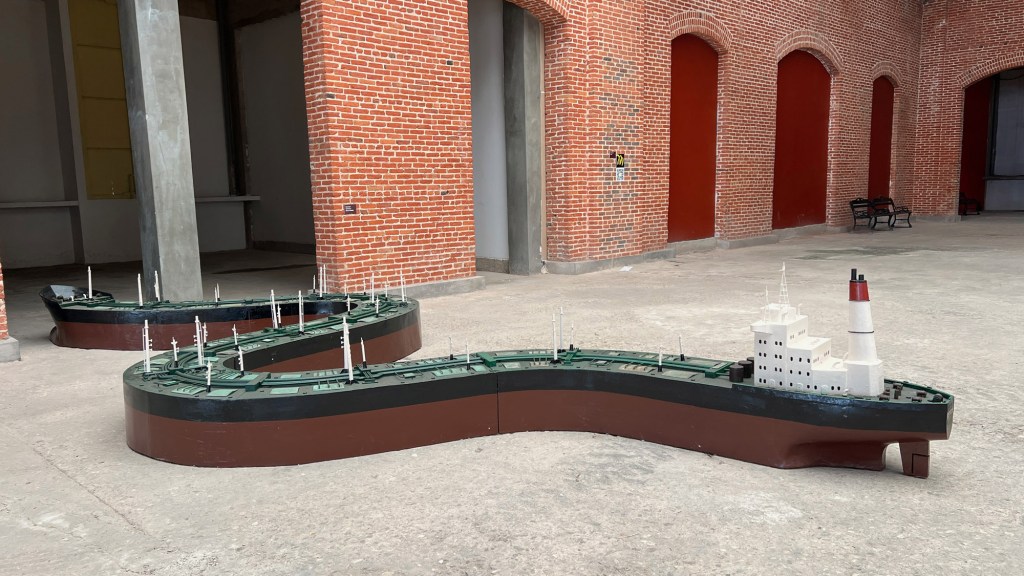
Buque Petrolero (oil tanker) is a collaboration between Eulises Niebla and Reynerio Tamayo. In a time when Cuba is facing increasing difficulty to afford and to procure it due to the US embargo and sanctions, this snaking barge made in 2009 is as relevant as ever: a symbol of desire and frustration.

Felipe Dulzaides’s Murales de Siempre (forever murals) are a play on didactic murals painted in offices and on state-owned buildings. He reduces them to their most basic aesthetic elements, yet they retain a sensibility immediately evident to anyone who has spent time in post-revolution Cuba. With the slogans removed, does it matter if the message remains embedded in the form? Or is there space now for something else to emerge?
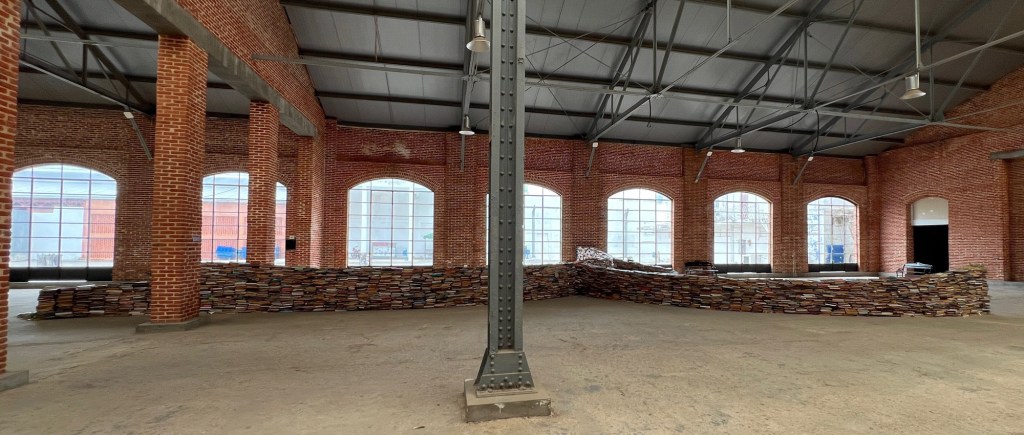
There’s only one real way to grasp the size and breadth of El peso de la historia (the weight of history): to wander from one end to another, dipping into the sectioned wall. Composed of books (mostly political works), the stacks are shown in the process of giving way under their own weight, scattered on the concrete floor. A far terminus of the piece is covered in broken glass and ends abruptly. Outwardly menacing, the barrier doesn’t actually prevent anyone from witnessing the full extent of the crumbling facade of words and ideas.
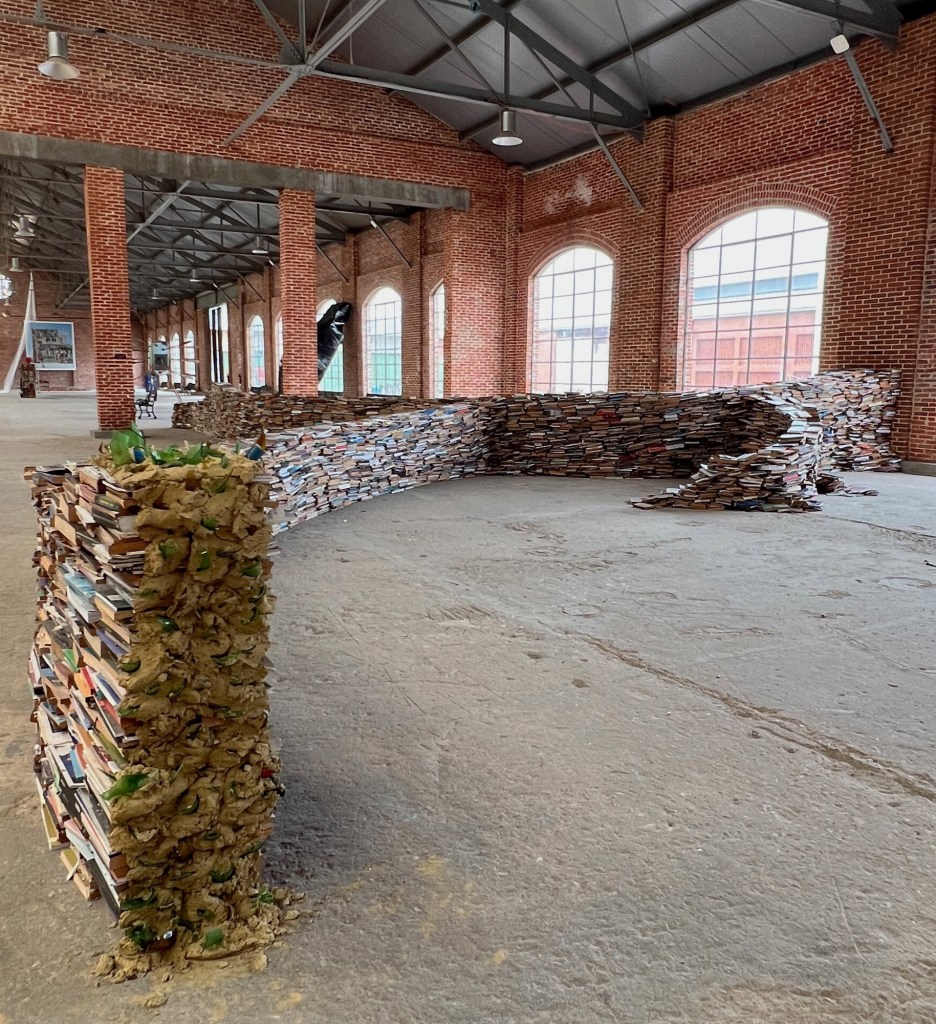
History is both a construct and a reality, full of contradictions borne by each generation. This piece was impressively sad, ambitious and world-weary. Mostly, though, it felt true. As I situated myself in the Estación, once the hub of transportation for a bustling city, I couldn’t help but also feel the weight of Havana. It’s been crumbling for decades now for a host of reasons, including a shift in US policy away from the Obama administration’s relative openness back to a punitive approach. The city’s deterioration has accelerated owing to the pandemic, the subsequent emigration of more than 10% of its population, and two hurricanes.
The 15th biennial, especially at this moment in Cuba’s history, forces us to confront uncomfortable realities. It also suggests that art – with its power to give voice to our humanity, bring consolation, express pain and desire, explore ideas, and bind communities – has some role in alleviating suffering.
“15 Bienal de La Habana: Horizontes Compartidos,” Havana, Cuba. November 15, 2024 – February 28, 2025.
About the author: Katarina Wong is an artist and and the author of Three Threads, a weekly newsletter that uses art to explore personal creativity.

